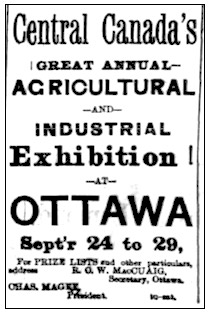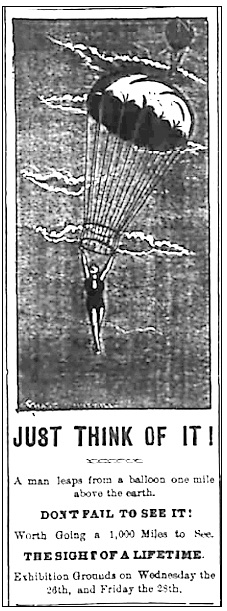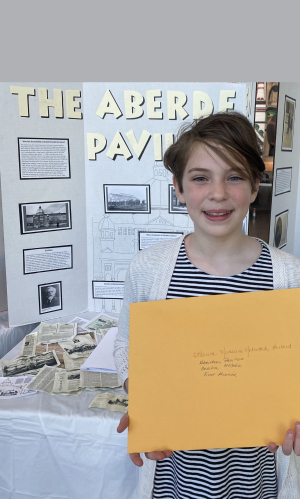The Aberdeen Pavilion: A Community Landmark
My Day at the Ottawa Regional Heritage Fair
Hi, my name is Cece and I recently participated in the Ottawa Regional Heritage Fair and won the Ottawa Museum Network Award. My topic was the Aberdeen Pavilion, which is a building in the middle of Lansdowne Park in Ottawa.
Leading up to the fair, I did a lot of research which included going to the City of Ottawa Archives. Going to the Ottawa Archives was a wonderful experience. Once there, I asked the librarian how to access the materials I needed. I did not end up ordering items from the vault, but I did find many photos, booklets, and newspaper clippings. I scanned them onto a USB drive then transferred them onto a Google Doc and printed them out. I also put a lot of time into my tri-fold presentation board and table display.
The fair was held at the Canadian Museum of History. During the fair, my day was split up into three rotations. In the first section, I had lunch. Then I was judged. At the end during a heritage workshop in the museum, I explored various Canadian artifacts. After my three rotations were done it was time for the award ceremony. I was not expecting to win an award so imagine my surprise when my name was called. It was so much fun, and I saw many of my friends and got the chance to see their projects. A couple of my favorite projects were about the Diefenbunker (which I recently toured) and Japanese internment camps.
A Bit About the Aberdeen Pavilion
Let me tell you a bit about the Aberdeen Pavilion. The Aberdeen Pavilion is a building in the heart of Ottawa. It is a heritage building and a community landmark. It also hosts the local farmers market on weekends. The Pavilion is a yellow color with light green trim. Its roof is silver. Its width is 40 meters, its height is 22 meters, and its length is 94 meters. It is the only large-scale exhibition building from the 1800s.
The Aberdeen Pavilion was designed by the architect Moses C. Edey. Edey was born in 1845 in Wyman, Quebec. He died in 1919. The Pavilion was named after the Governor General Lord Aberdeen. It was built for the Central Canada Exhibition Association (CCEA) in 1898, who used it as a place to host agricultural fairs. In 1939 it was taken over by the Department of National Defense. It was also used as a skating rink where the original Ottawa Senators won the Stanley Cup. It was designated a Heritage Building in February 1984. But by late 1986 it was in such disrepair that it was condemned and then closed to the public in October 1987. It was going to be demolished but the officials decided to renovate the building with a budget of 5.3 million dollars. This was approved in July 1992. They finished the renovation on June 24, 1994. Now the building stands proudly in Lansdowne Park on display for everyone.
The Central Canada Exhibition
24 September 1888
For more than one hundred and twenty years, a feature of Ottawa life during the late summer or early fall was the Central Canada Exhibition. Now sadly defunct, the fair started as an agricultural and industrial exhibition, providing a venue for the farmers of eastern Ontario and western Quebec to display their products, share knowledge, and compete for prizes. It was also an opportunity for manufacturers to exhibit not only the latest agricultural equipment to potential buyers, but also other types of wares. Arts and crafts were additionally featured. It wasn’t all work, however. There was also entertainment, including circus acts, rides, games, and, of course, copious amounts of food and drink.
The Central Canada Exhibition began out of civic dissatisfaction with the annual Provincial Exhibition that was organized by the Agricultural and Arts Association of Ontario. The Provincial Exhibition, which was founded in 1845, moved from city to city in Ontario. However, local or civic fairs, including the Toronto Industrial Fair established in 1879 (to become the Canadian National Exhibition in 1912), began to compete with the more staid Provincial Exhibition. Although Ottawa hosted the Provincial Exhibition in 1887, it was not a great success. Many charged that the fair had been mismanaged, and that it had not been adequately promoted. As well, it appears that the Exhibition’s management irritated the wrong people. Ottawa’s Mayor Stewart was not amused when he was forced to pay a small fee for his horse when he arrived at Lansdowne Park, the venue that the city had provided rent-free to the Provincial Exhibition’s organizers.
Almost immediately after the Provincial Exhibition closed that year, a meeting was organized at Ottawa City’s Hall to discuss the merits of establishing Ottawa’s own annual agricultural fair. Chaired by Mayor Stewart, a long list of Ottawa’s great and worthy attended to voice their support, including Erskine Henry Bronson, a prominent Ottawa businessman and the member of the provincial assembly for Ottawa. (Bronson Avenue is named in his honour.) The Mayor also obtained the backing of the Premier, Sir John A. Macdonald.
 Advertisement for the first annual Central Canada Exhibition
Advertisement for the first annual Central Canada Exhibition
The Evening Journal, 15 August 1888In March 1888, the Province of Ontario incorporated the Central Canada Exhibition Association for the promotion of “industries, arts and sciences generally,” and gave it “full power and authority to hold permanent or periodical exhibitions.” Ottawa’s mayor and three members of city council were appointed to the Association, along with representatives from eastern Ontario as far west as Kingston, and from western Quebec as far east as the Island of Montreal. In addition to agricultural groups, a long list of scientific and artistic groups were also to be represented, including the Ontario College of Pharmacy, the Ottawa School of Arts and Sciences, the Ottawa Literary and Scientific Society, the Geological Survey of Canada, and the Art Association of Ottawa.
In support of the new agricultural exhibition, the City provided $10,000 to upgrade the Exhibition Grounds at Lansdowne Park. These included the relocation of a number of buildings, the erection of a grandstand for two thousand people, and the construction of new floral and machinery halls. Opposite the grandstand, a temporary stage was also built for performances. The cattle sheds, horse boxes and the poultry sheds were freshly white-washed. The fairgrounds were also wired for electricity to permit the fun to continue after dusk; electric streetlights had come to Ottawa three years earlier. The City also made improvements to Elgin and Bank Streets that led to the Exhibition Grounds. The admission fee to the Exhibition was 25 cents. A single carriage with a driver got in for 50 cents, with 25 cents charged for each additional passenger.
All was ready when Exhibition’s doors opened on 24 September 1888; the official inaugural ceremonies took place the following day in the presence of the Governor General, Lord Stanley of Preston. Ottawa was dressed to the nines for the event, with its store windows decorated and flags and bunting everywhere. There were close to 5,000 entries to the Exhibition, twice the number of the previous year’s Provincial Exhibition. Over three hundred horses were on show, including standard horses, blood horses, carriage horses, roadsters, and saddle horses, hunters and heavy draught horses. In the cattle shed could be found Durhams, Ayrshires, Galloways, Herefords, Holsteins, and Polled Angus. In the poultry shed, there were 110 entries in twenty varieties of chicken, including Plymouth Rooks, Cochin Chinas, White and Black Polands, and White Leghorns, as well as turkeys, geese, and pigeons.
The main building housed miscellaneous manufactures, ranging from hardware and harrows, to home furnishings, including the latest in labour-saving devices such as mangles, washing machines, and sewing machines. There were displays of “fancy work,” embroidery, paintings in watercolours and oils, and an “endless display of tidy and kindergarten work.” Two hundred entries were devoted to textile goods alone made from Canadian wool. In the carriage department, one hundred vehicles were on display—coaches, landaus, coupes, phaetons, tea carts, sulkies, 2-horse teams, market wagons, and sleighs. In an annex to the main building, R.J. Devlin, a large Ottawa department store, put on a massive display of furs with everything from musk ox to Persian lamb. Visitors were wowed by two stuffed polar bears and a Bengal tiger skin that stretched twenty feet from nose to tip of its tail.
The newly constructed machinery hall housed steam and horse-powered threshers and separators, ploughs, reaping and mowing machines, combines, windmills and stump extractors—everything a farmer could wish for. A “waterous engine” driving “hundreds of busy wheels,” transfixed visitors. A massive collection of minerals was also on display. All categories of machines, animals, plants, and crafts were judged with monetary prizes ranging from $25 to $5 in addition to gold, silver and bronze medals for first, second and third places, respectively. Diplomas were also awarded.
 Advertisement for the parachute jump, 1st Annual Central Canada Exhibition
Advertisement for the parachute jump, 1st Annual Central Canada Exhibition
The Evening Journal, 19 September 1888.After the opening ceremonies, described as a “very recherché affair,” by the Ottawa Evening Journal,” there was a luncheon for the dignitaries, hosted by President Charles Magee of the Exhibition Association. The guests of honour were Lord Stanley and Acting Mayor Joseph Erratt; Mayor Stewart was in England and missed the Exhibition. He did, however, supply a number of cases of champagne to toast his health. Unsurprisingly, the mayor’s tent was very popular that afternoon, something that couldn’t have gone over well with the Women’s Christian Temperance Union who had been grudgingly allowed to have a booth at the Exhibition. Music for the day was provided by the band of the Governor General’s Foot Guards.
That evening, with the electric lights illuminating the Exhibition grounds, the games began over the objections of clergymen who objected “most strongly” about turning an agricultural fair, aimed at improving and instructing people, into anything that resembled fun. Roman chariot races were held on the race track with teams of eight horses. This was followed by a series of circus acts. The Zanfretta family of New York performed a high-wire act with Mr Zanfretta carrying Miss Zanfretta across a rope suspended fifty feet in the air. Levanian and McCormick performed on the trapeze, while Professor Chiton juggled, and the Rice Brothers performed acrobatics. Other performers included Val Vina, a comic juggler, and Philion, the French Necromancer. Mr Topley, Ottawa’s premier photographer, also provided stereopticon views of old and new Ottawa. To cap the evening’s festivities was a brilliant fireworks display.
The next day, the highlight of the Exhibition, was the ascension of a hot-air balloon to 6,000 feet, from which a Professor Williams would make a parachute jump. The event was described as “the greatest out-door wonder the world has ever witnessed.” Ballooning and parachuting in the 1880s was not for the faint at heart. Balloonists were frequently injured or killed. One contemporary observer commented that “we are no more masters of the balloon than they [the Montgolfier brothers] were a century ago.” To jump from a balloon was an order of magnitude even more dangerous given the primitive parachutes of the time.
Late in the day, Professor Williams was ready to make his ascent. In front of an excited crowd of 20,000 people, he began to inflate his balloon over a fire. A dozen or so men volunteered to shake out the canvas as the bag inflated and hold onto the balloon to steady it. When the balloon was inflated, Williams got into the basket, and the rope securing the balloon over the top was released, leaving the men alone restraining it. Williams gave the command to release. Eleven men did so, but one held on, and was quickly carried into the air. Williams shouted up to the man “For God’s Sake, Drop!” But, the man ignored the plea, and within seconds, the balloon had carried him hundreds of feet into the air. Silently, he held on for dear life. At one point, the man tried to catch his foot onto one of the ropes that suspended the basket. But he failed and became motionless again. When his strength gave out, he plunged to his death, striking the ground in the backyard of a house near Bank Street close to the Mutchmor race track (now the site of Mutchmor Public School). Throughout his ordeal, the man never said a word. Powerless to do anything, Professor Williams jumped shortly afterwards, his parachute carrying him safely to the ground near the St Louis dam at Dow’s Lake as his balloon slowly sank as the air inside it cooled.
Below, the spectators first thought that the drama being played out high in the sky was part of the show. But cheers turned to moans as the man’s desperate plight became apparent. When the man’s grasp finally failed, hundreds of people rushed to the place where he hit the ground. A doctor, who happened to have his medical satchel with him, attempted to revive the young man, but it was hopeless. His body was carried inside a nearby home and laid out on the floor of the front room. As he carried no identification, it took police some time to identify him. He was 24-year old Tom Wensley of 107 Chapel Street. His father was an engineer for the Public Works Department. Having occurred in front of thousands of witnesses, Wensley’s death was ruled an accident by the police. There was no inquest. The Central Canada Exhibition paid the funeral expenses for the unfortunate man. Despite this horrific event, Professor Williams took to the air once again later in the week. This time, everybody let go on his command. He landed by parachute without incident.
The first Central Canada Exhibition was judged a great success. More than 50,000 people attended the six-day event. (Ottawa’s population was only about 40,000 at the time.) Most came by horse-drawn cab or bus, or by boat along the Rideau Canal. Schools closed for a day to allow students to attend. Civil servants and Chaudière mill workers were given a half-day holiday to permit them to see the sights. Thousands also came from outlying towns and villages. Ottawa hotels were all reported to be full during Exhibition week, except for the upscale Russell House. Merchants did a roaring trade both at the fair and outside. Financially, the Exhibition ended in the black, with revenues of roughly $12,000, slightly in excess of expenditures. The Ottawa Evening Journal commended all who participated in making the Exhibition a success, saying that the fair was a “splendid promise for the future.”
And indeed it was. It was the start of an event that was held annually, except during World War II, until well into the twenty-first century. Over time, however, with farming playing an ever diminishing role in Canadian life, the balance of activities at the Exhibition shifted. Agriculture, the raison d’être of the fair, was increasingly relegated to the sidelines in favour of midway entertainments and musical performances. But against the dazzling array of twenty-first century amusements and the temporary loss of its home at Lansdowne Park to redevelopment, the Exhibition could not compete. It died of ennui, with the last Ottawa SuperEx, as it became known, held in 2010. Its last Board of Directors disbanded in 2015.
Sources:
Ottawa Evening Journal (The), 1887. “The Value of the Provincial Exhibition,” 22 September.
——————————–, 1887. “Ottawa Is Willin’,” 6 October.
——————————–, 1888, “Central Canada Exhibition Association, 31 March.
——————————–, 1888. “The $210,000 By-Law,” 4 April.
——————————–, 1888. “Exhibition Notes,” 4 August.
——————————–, 1888. “Exhibition Matters,” 25 August.
——————————–, 1888. “The Light Side-Dishes To The Solid Central Fair,” 15 September.
——————————–, 1888, “Ministers Object,” 17 September.
——————————–, 1888. “Ottawa’s Great Fair,” 24 September.
——————————–, 1888. “Ottawa’s Great Fair,” 26 September.
——————————–, 1888. “Ottawa’s Great Fair,” 27 September.
——————————–, 1888. “Wensley’s Death,” 27 September.
——————————–, 1888. “Notes,” 28 September.
——————————–, 1888. “The Parachute Drop,” 29 September.
——————————–, 1888. “Good-By Central,” 29 September.
——————————–, 1888. “The Exhibition,” 29 September.
——————————–, 1888. “Adventures In The Air,” 4 October.
Story written by James Powell, the author of the blog Today in Ottawa's History.
Retired from the Bank of Canada, James is the author or co-author of three books dealing with some aspect of Canadian history. These comprise: A History of the Canadian Dollar, 2005, Bank of Canada, The Bank of Canada of James Elliott Coyne: Challenges, Confrontation and Change,” 2009, Queen’s University Press, and with Jill Moxley, Faking It! A History of Counterfeiting in Canada, 2013, General Store Publishing House, Renfrew, Ontario. James is a Director of The Historical Society of Ottawa.







